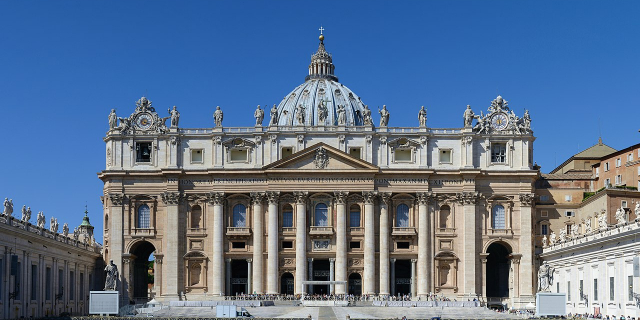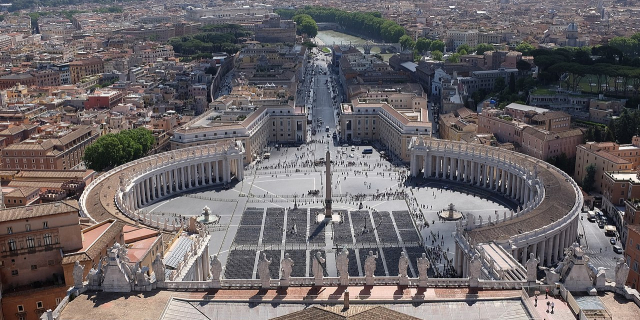The Sistine Chapel (; Latin: Sacellum Sixtinum; Italian: Cappella Sistina [kapˈpɛlla siˈstiːna]) is a chapel in the Apostolic Palace, the pope's official residence in Vatican City. Originally known as the Cappella Magna ('Great Chapel'), the chapel takes its name from Pope Sixtus IV, who had it built between 1473 and 1481. Since that time, the chapel has served as a place of both religious and functionary papal activity. Today, it is the site of the papal conclave, the process by which a new pope is selected. The fame of the Sistine Chapel lies mainly in the frescoes that decorate the interior, most particularly the Sistine Chapel ceiling and The Last Judgment, both by Michelangelo.
During the reign of Sixtus IV, a team of Renaissance painters that included Sandro Botticelli, Pietro Perugino, Pinturicchio, Domenico Ghirlandaio and ...Read more
The Sistine Chapel (; Latin: Sacellum Sixtinum; Italian: Cappella Sistina [kapˈpɛlla siˈstiːna]) is a chapel in the Apostolic Palace, the pope's official residence in Vatican City. Originally known as the Cappella Magna ('Great Chapel'), the chapel takes its name from Pope Sixtus IV, who had it built between 1473 and 1481. Since that time, the chapel has served as a place of both religious and functionary papal activity. Today, it is the site of the papal conclave, the process by which a new pope is selected. The fame of the Sistine Chapel lies mainly in the frescoes that decorate the interior, most particularly the Sistine Chapel ceiling and The Last Judgment, both by Michelangelo.
During the reign of Sixtus IV, a team of Renaissance painters that included Sandro Botticelli, Pietro Perugino, Pinturicchio, Domenico Ghirlandaio and Cosimo Rosselli, created a series of frescos depicting the Life of Moses and the Life of Christ, offset by papal portraits above and trompe-l'œil drapery below. These paintings were completed in 1482, and on 15 August 1483 Sixtus IV celebrated the first mass in the Sistine Chapel for the Feast of the Assumption, at which ceremony the chapel was consecrated and dedicated to the Virgin Mary.
Between 1508 and 1512, under the patronage of Pope Julius II, Michelangelo painted the chapel's ceiling, a project that changed the course of Western art and is regarded as one of the major artistic accomplishments of human civilization. In a different political climate, after the Sack of Rome, he returned and, between 1535 and 1541, painted The Last Judgment for Popes Clement VII and Paul III. The fame of Michelangelo's paintings has drawn multitudes of visitors to the chapel ever since they were revealed five hundred years ago. According to recent studies, the Sistine Chapel is influenced by the thought of Joachim of Fiore. The monk and philosopher thus influenced the vision and the iconographic project for the representation of the Last Judgment. Michelangelo's frescoes with an eschatological theme are therefore an artistic development of the various Joachim writings of the 12th century about the apocalypse and the last days.
The first stage in the decoration of the Sistine Chapel was the painting of the ceiling in blue, studded with gilt stars,[1] and with decorative borders around the architectural details of the pendentives. This was entirely replaced when Michelangelo came to work on the ceiling in 1508.
Of the present scheme of frescos, the earliest part is that of the side walls. They are divided into three main tiers. The central tier of the walls has two cycles of paintings, which complement each other, The Life of Moses and The Life of Christ. They were commissioned in 1480 by Pope Sixtus IV and executed by Domenico Ghirlandaio, Sandro Botticelli, Pietro Perugino, Cosimo Rosselli and their workshops. They originally ran all round the walls, but have since been replaced on both end walls.
The project was perhaps supervised by Perugino, who arrived at the chapel prior to the Florentines. It is probable that the commission of Ghirlandaio, Botticelli and Roselli was part of a reconciliation project between Lorenzo de' Medici, the de facto ruler of Florence, and Pope Sixtus IV. The Florentines started to work in the Sistine Chapel in the spring of 1481.
Beneath the cycles of The Life of Moses and The Life of Christ, the lower level of the walls is decorated with frescoed hangings in silver and gold. Above the narrative frescos, the upper tier is divided into two zones. At the lower level of the windows is a Gallery of Popes painted at the same time as the Lives. Around the arched tops of the windows are areas known as the lunettes which contain the Ancestors of Christ, painted by Michelangelo as part of the scheme for the ceiling.
The ceiling was commissioned by Pope Julius II and painted by Michelangelo between 1508 and 1512. The commission was originally to paint the twelve apostles on the triangular pendentives which support the vault; however, Michelangelo demanded a free hand in the pictorial content of the scheme. He painted a series of nine pictures showing God's Creation of the World, God's Relationship with Mankind, and Mankind's Fall from God's Grace. On the large pendentives he painted twelve Biblical and Classical men and women who prophesied that God would send Jesus Christ for the salvation of mankind, and around the upper parts of the windows, the Ancestors of Christ.
In 1515, Raphael was commissioned by Pope Leo X to design a series of ten tapestries to hang around the lower tier of the walls.[2] The tapestries depict events from the Life of St. Peter [four tapestries] the Life of St. Paul [six tapestries], the founders of the Christian Church in Rome as described in the Gospels and the Acts of the Apostles. Work began in mid-1515. Due to their large size, manufacture of the hangings was carried out in Brussels, and took four years under the hands of the weavers in the shop of Pieter van Aelst.[3] Raphael's tapestries were looted during the Sack of Rome in 1527 and were either burnt for their precious metal content or were scattered around Europe. In the late 20th century, a set was reassembled from several further sets that had been made after the first set, and displayed again in the Sistine Chapel in 1983. The tapestries continue to be used at occasional ceremonies of particular importance. The full-size preparatory cartoons for seven of the 10 tapestries are known as the Raphael Cartoons and are in London.[4]
At this point, the decorative scheme displayed a consistent iconographical pattern. The tier of Popes, which, in the scheme intended by Pope Julius, would have appeared immediately below the Twelve Apostles, would have emphasised the apostolic succession. It has been argued that the present scheme shows the two Biblical Testaments merged in order to reveal the Old predicting and framing the New, synthesizing the logic of the Christian Bible.[5]
This was disrupted by a further commission to Michelangelo to decorate the wall above the altar with The Last Judgment, 1537–1541. The painting of this scene necessitated the obliteration of two episodes from the Lives—the Nativity of Jesus and the Finding of Moses; several of the Popes; and two sets of Ancestors.




































Add new comment